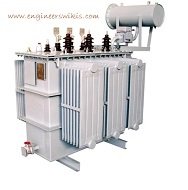
The rating of a power transformer refers to its specifications and capacity to handle electrical power. The rating provides information about the transformer’s voltage, power capacity, and other parameters. Here are the key ratings commonly associated with power transformers:
- Power Rating: The power rating of a transformer indicates its capacity to handle electrical power. It is expressed in units of Volt-Amperes (VA) or kiloVolt-Amperes (kVA). The power rating defines the maximum power that the transformer can transfer from the primary winding to the secondary winding without exceeding its thermal limits.
- Voltage Rating: The voltage rating specifies the maximum voltage that the transformer can handle on its primary and secondary windings. It includes the primary voltage, which represents the voltage supplied to the transformer, and the secondary voltage, which is the voltage delivered by the transformer. Voltage ratings are typically given in kilovolts (kV) or volts (V), depending on the transformer’s size and application.
- Frequency Rating: The frequency rating indicates the frequency of the alternating current (AC) power system for which the transformer is designed. The most common frequency for power systems is 50 or 60 Hertz (Hz). Transformers are designed to operate at a specific frequency, and using them outside their rated frequency may result in performance issues or damage.
- Impedance Rating: The impedance rating of a transformer refers to its internal impedance, which is the opposition to the flow of current and is measured in ohms. It represents the ability of the transformer to limit short-circuit currents and is important for system protection and coordination. The impedance rating is typically expressed as a percentage, such as 4% or 6%.
- Efficiency Rating: Efficiency rating indicates the efficiency of a transformer in converting electrical power from the primary side to the secondary side. It represents the ratio of output power to input power and is expressed as a percentage. Higher efficiency transformers are more energy-efficient and result in reduced energy losses.
- Cooling Class: Transformers are classified based on their cooling methods, which determine how they dissipate heat generated during operation. Common cooling classes include ONAN (Oil Natural Air Natural), ONAF (Oil Natural Air Forced), and OFAF (Oil Forced Air Forced). The cooling class affects the transformer’s power rating and its ability to handle higher loads.
These ratings are crucial for selecting and specifying transformers based on the requirements of the electrical system. Transformers with higher ratings can handle larger power capacities and higher voltages, while lower-rated transformers are suitable for smaller applications. It’s important to ensure that the transformer rating matches or exceeds the requirements of the system to ensure safe and efficient operation.
